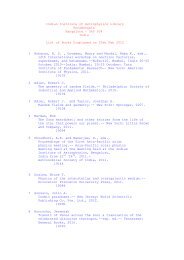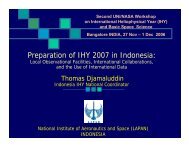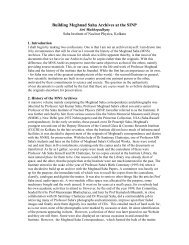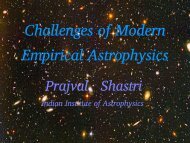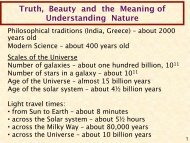PSR B0329+54 – A pulsar with unique polarization properties
PSR B0329+54 – A pulsar with unique polarization properties
PSR B0329+54 – A pulsar with unique polarization properties
Create successful ePaper yourself
Turn your PDF publications into a flip-book with our unique Google optimized e-Paper software.
<strong>PSR</strong> <strong>B0329+54</strong> <strong>–</strong> A <strong>pulsar</strong><br />
<strong>with</strong> <strong>unique</strong> <strong>polarization</strong><br />
<strong>properties</strong><br />
Dipanjan Mitra<br />
NCRA<br />
collaborators: J. M. Rankin, Y. Gupta
Introduction to <strong>pulsar</strong>s<br />
Pulsars are rotating neutron stars born<br />
from core collapse of Type II supernova<br />
Periods of <strong>pulsar</strong>s range from 1.3 msec to<br />
8.5 sec<br />
Pulsars are seen to slow down at a steady rate<br />
Pulsar Magnetic fields vary from 10 8 to 10 13<br />
Gauss<br />
Pulsar emits pulsed radiation across the whole<br />
electromagnetic spectrum
Radio Emission <strong>properties</strong><br />
Radio emission from <strong>pulsar</strong>s has high brightness temperature (10 28<br />
k) and is coherent and broadband in nature<br />
Radiation is highly polarized and hence has a non thermal origin<br />
Emission originates mostly from dipolar magnetic field line about<br />
hundreds of km above the surface of the NS.<br />
Emission is due to particles (or coherent bunch) moving along<br />
magnetic field <strong>with</strong> high lorentz factors (200)<br />
Emission is in the form of nested cones<br />
What emission mechanism is set up in a <strong>pulsar</strong> to obey such emission<br />
ion<br />
<strong>properties</strong> is still unknown
THE GEOMETRICAL PREMISE
More radio emission <strong>properties</strong><br />
PULSARS ARE BROAD-BAND EMITTERS<br />
The coherent<br />
radio emission<br />
from <strong>pulsar</strong>s has<br />
a steep spectral<br />
index ( -1.7) !
Simultaneous observations<br />
(Karastergiou et al 2003)
RVM seen in <strong>PSR</strong> B2045-16<br />
(Mitra and Li 2004)
The Rotating vector Model<br />
This model is<br />
extensievely used to<br />
find the viewing geometry<br />
α , the angle between<br />
the rotation axis and the<br />
magnetic axis!<br />
β, the angle between the<br />
magnetic axis and the<br />
observers line of sight
Shape of the <strong>pulsar</strong> beam
Example of nested cone emission in <strong>PSR</strong> <strong>B0329+54</strong><br />
Location of 9 emission components<br />
<strong>PSR</strong> <strong>B0329+54</strong><br />
325 MHz<br />
<strong>PSR</strong> <strong>B0329+54</strong><br />
606 MHz<br />
Intensity (a.u.) Profile Number<br />
9<br />
8<br />
7<br />
6<br />
5<br />
4<br />
3<br />
2<br />
1<br />
VIII<br />
VIII<br />
I<br />
I<br />
VI<br />
II<br />
II<br />
VI<br />
III<br />
III<br />
V<br />
VII<br />
IV<br />
IV<br />
V<br />
VII<br />
IX<br />
IX<br />
9<br />
8<br />
7<br />
6<br />
5<br />
4<br />
3<br />
2<br />
1<br />
VIII<br />
VIII<br />
I<br />
I<br />
VI<br />
II<br />
II<br />
VI<br />
III<br />
III<br />
VII<br />
V<br />
IV<br />
V IV<br />
VII<br />
IX<br />
IX<br />
Cone Number<br />
VIII I VI<br />
II<br />
III<br />
1<br />
2<br />
3<br />
4<br />
V<br />
VII<br />
IV<br />
IX<br />
Phase (deg)<br />
Phase (deg)<br />
(Gangadhara and Gupta 2003)<br />
Phase (deg)<br />
606 MHz 325 MHz
Average pulse profiles
Complexities in <strong>pulsar</strong> <strong>polarization</strong><br />
<strong>properties</strong><br />
Presence of orthogonal<br />
<strong>polarization</strong> mode<br />
(Gangadhara et al 1997)
<strong>PSR</strong> <strong>B0329+54</strong><br />
A bright <strong>pulsar</strong> about a kpc away<br />
Period ~ 714 msec, , B ~ 10 12 Gauss,<br />
Age~ 5.5 myr<br />
Has three nested cones of emission and a<br />
central core emission
Presence of orthogonal <strong>polarization</strong> mode in<br />
<strong>B0329+54</strong><br />
(Gil & Lyne 1994)
How are OPM’s produced<br />
One possible explanation proposed is that the<br />
magnetospheric plasma is birefringent and causes the<br />
linear <strong>polarization</strong> to split into ordinary and extraordinary<br />
mode<br />
The ordinary mode travels along the magnetic field lines<br />
and the extraordinary mode is perpendicular to it. The O<br />
mode is prone to further refraction while the X mode<br />
travels unaffected.<br />
The average PA curve will get distorted depending on<br />
which mode dominates and by what fraction
<strong>PSR</strong> <strong>B0329+54</strong><br />
The central distortion<br />
can be a result of<br />
refraction of the ordinary<br />
mode<br />
(Edwards & Stappers<br />
2004)
Our observation of <strong>PSR</strong> <strong>B0329+54</strong><br />
325 MHz<br />
GMRT
610 MHz (GMRT) 2.6 GHz (Effelsberg(<br />
Effelsberg)
Intensity dependent PA
Emission height of the O and X<br />
mode<br />
For emission arising at<br />
a given height<br />
Abberation causes the<br />
steepest gradient to<br />
lag w.r.t the center of<br />
the pulse profile.<br />
The shifts are seen to<br />
be the same for X and O<br />
mode, and hence the<br />
emission heights are same<br />
for both the modes
Mode separated profiles
The core component appears<br />
earlier <strong>with</strong> intensity<br />
(also seen by Mckinnon and Hankins 1993)
Summary<br />
For the first time we have seen the phenomenon of<br />
intensity dependent PA<br />
The phenomenon is invariant across wide frequency<br />
range and we can rule out the effect of refraction<br />
Intensity variation can happen due to sudden increase of<br />
charged particles flowing along the magnetic field lines<br />
Increased particles can cause distortions in the magnetic<br />
field and produce the PA variations observed. Further<br />
theoretical modelling is needed to understand this effect.
Pulsar and TypeII supernova<br />
Crab nebula and its <strong>pulsar</strong><br />
(Chandra observations)<br />
back<br />
Pulsar found in G21.5-0.9<br />
using GMRT (Gupta, Mitra, Green, Acharya)



